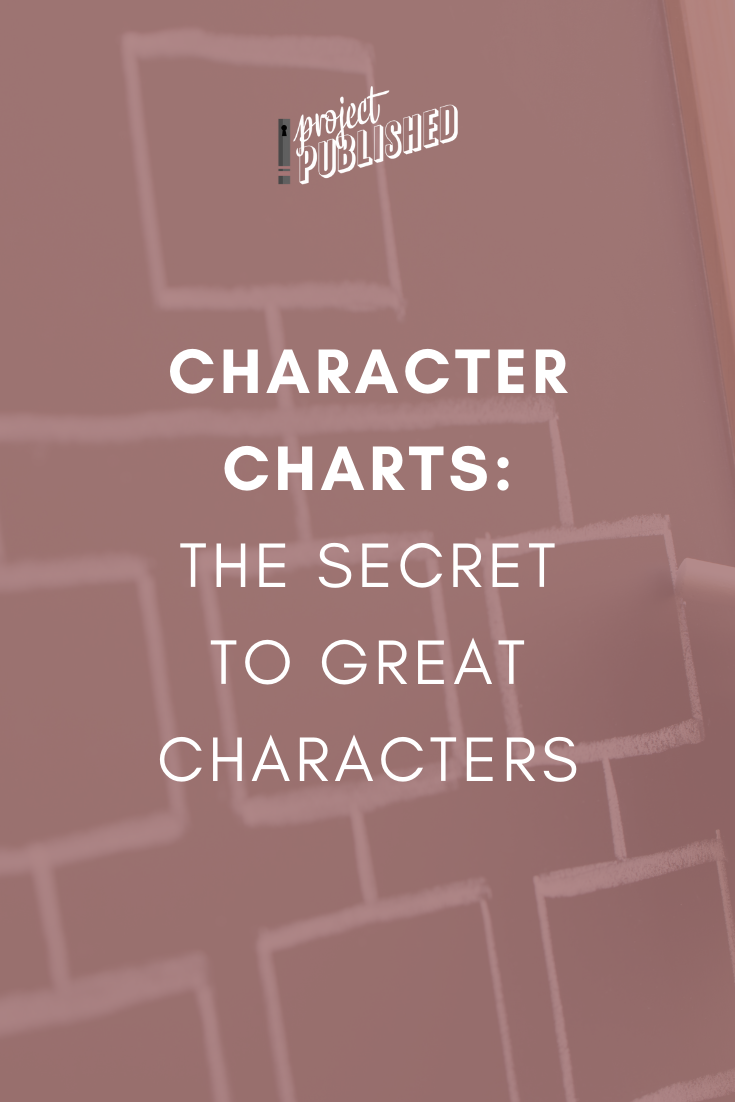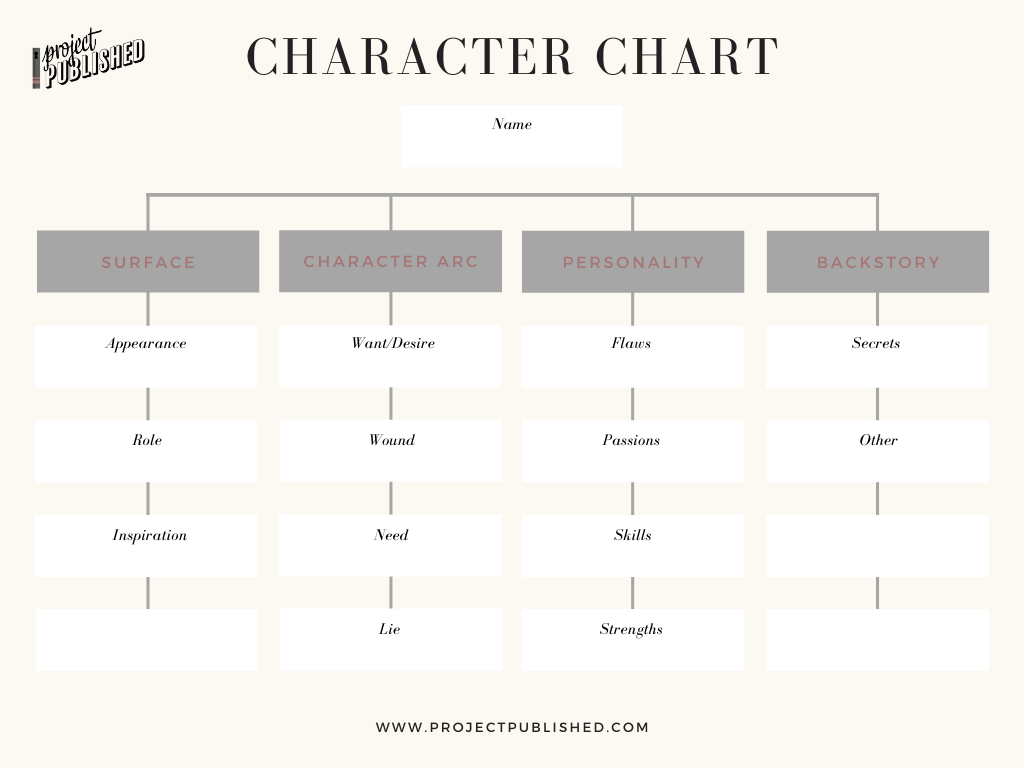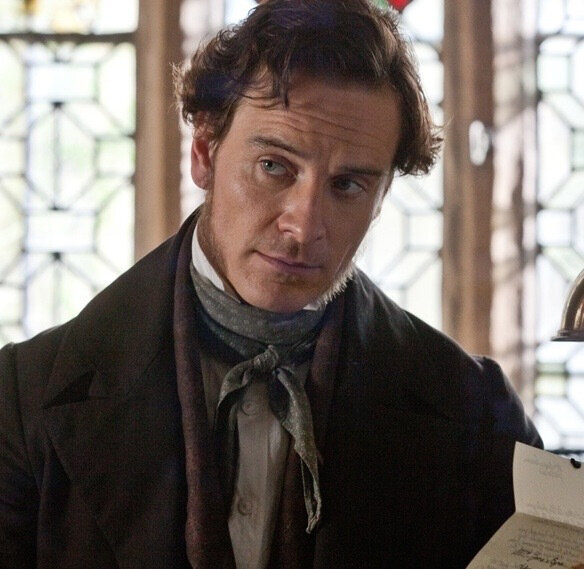Character Charts: The Secret to Great Characters
Characters are one of the three main pillars of storytelling that are most discussed: Plot, character, and theme.
But how do you create a good character?
When I first began writing and outlining my book, I found character profiles with hundreds of questions. I researched writing prompts that encouraged you to fill in pages and pages about your characters.
That’s all good and well. And sometimes helpful. Many people advocate for these because they have worked for them.
But I always found myself getting bored or confused when I tried to fill in these lists.
Instead, there have been two main things that have helped me flesh out well-rounded, interesting characters, and that I have observed when analyzing well-rounded, interesting characters from other stories.
Here they are:
Write the story.
No matter how much I tried to plot and plan and outline and brainstorm and research, the number one thing that helped me get to know my characters was writing them. Writing their interactions and reactions and thoughts and dialogue.
I remember reading an interview with an author once (can’t remember who!) who said she typically didn’t feel like she really knew her characters until her first draft was completely finished. And even then she was discovering more about them as she edited and revised.
This might seem disheartening, but it’s true. Write, write, write. And your characters will come alive.
Now, I know you opened this because you were looking for a quick fix to creating good characters. Come on. You know I’ve got you covered! Enter resource number two.Character charts.
Again, early on in my research, I came across a blog post about a form of character charts. (I’ve tried to find it since to no avail.) This chart was mostly about keeping track of big casts of character, and as such, it provided a couple of easy and simple ways to distinguish your characters from one another.
Since then, I have expanded on that initial chart to include the most important things for creating interesting, well-developed characters.
These charts consist of only 13 questions. And these questions have answers that range from one word to one or two sentences. Pretty simple, yes? I turn to these charts again and again as I’m writing. And the more I study them, the more I understand my characters and the more nuanced my stories become.Are you ready for the questions?
Character Chart Questions:
Surface Questions
1) Appearance
Pretty straightforward. This is where you fill in the details about what your character looks like physically. Things like hair and eye color, striking features, and specific words you use to refer to this character. My notes typically only have 2-5 features about the character.
But here is the most important thing I have discovered when filling out this section. If you do this, it can take your book to a whole new level.
Make your character obvious with just a few well-chosen words.
Think about Harry Potter. You know Snape is coming around the corner if you hear words like greasy or hook-nosed or curtain of black hair. You know it’s Dumbledore if there is a mention of half-moon spectacles or twinkling blue eyes or a long white beard.
Heck, you can even know it’s his handwriting if the words long and slanting appear next to each other. Hermione is bushy and buck-toothed. Ron is gangly, has freckles, and, of course, flaming red hair.
Most of the characters are easily identified within the text because they have been branded with very specific word choices. This takes any confusion away from your reader as they are reading. And confusion (unless very strategically used) is never a good thing.
2) Role
This is perhaps the least helpful section as you continue with your writing, but can be very useful when first outlining.
For this question, I simply fill in what the character’s role is within the story. Is she the protagonist? The love interest? Sidekick? Mentor? Contagonist? Antagonist? You get the picture.
3) Inspiration
This is very simple. Is there a character in fiction or someone in your real life whom you are taking inspiration from? Put it here.
Character Arc Questions
1) Want/Desire
This is where we start getting into the most important information you’ll have about your character. Your character’s want will drive their actions through your story. In Throne of Glass, Celaena wants freedom. She says it very explicitly in the first few pages.
And it drives everything she does.
Your character’s burning desire becomes one of the most important drivers of your whole story.
Think about the one thing your character wants more than anything. And put it here.
If you’re ready to get a little more advanced, think about your character’s Wound/Ghost here (an event from their past that has harmfully colored their view of the world and/or themself).
Their Desire should stem from the Wound. Meaning the Wound has created a set of emotions in them and given them a purpose/goal for themselves.
For example, Harry Potter’s Wound has to do with being raised by the Dursleys and incessantly bullied.
This has created layers of emotion (unique to him - others with the same Wound might develop a completely different set of emotions) such as courage, spirit, self-sacrifice, and sometimes hot-headedness. It has also bolstered his Desire to protect others from bullies, which shows up again and again in the Harry Potter series. And importantly, in the Climax of the first book.
This is an advanced, but effective storytelling technique. Wound -> Desire -> Climax. They are all connected.
The emotions are important if you have a goal (which every author should) of crafting an emotionally compelling and impactful story. Dig deep. Think of emotions that might not be obvious at first glance, but that ring true for your character.
2) Need
Your character may want one thing, but that may not be (and in fact probably isn’t) what he needs.
So what does he need? To overcome a fear? To accept love from others? To stand up for what he believes in? Celaena from Throne of Glass needs to protect those who she cares about and who cannot protect themselves. And here’s the kicker. She may need to do that at the cost of her freedom.
Harry needs to fully allow others to help him. His Wound and Desire have him deflecting outside of himself, always doing the protecting.
At the end of book 1, it is Dumbledore and his mother (retroactively) who protect him. He would have died without helping at all if it hadn’t been for them. At the end of book 7, he must ask for help (from Neville, Ron, Hermione, and others) in order to defeat Lord Voldemort.
This only makes a story more interesting. If what your character needs actually comes at the cost of what he wants or by overcoming a leftover emotion from his Wound (like Harry’s self-sacrifice, which only becomes a fully evolved and useful emotion once he lets others in and sees himself through their eyes).
Is he willing to give up his burning desire? Hopefully, a stronger Character Arc will teach him to do so. But keep his need here for easy reference.
3) Lie
The Lie is another important piece of the Character Arc. The Lie is the opposition to your character’s need.
What is your character’s Lie? What does she believe about the world or about herself that is not true? (That also stems from her Wound.)
Woody believes his only worth is in being the favorite toy. But throughout his journey he realizes (his Need) he’ll be more fulfilled if he shares that love.
Personality Questions
1) Flaws
This is where you can really start to have fun.
A character is only interesting if they are flawed. Human. Realistic. So what flaws does your character struggle with? Selfishness? Vanity? Cowardice? Naivety? Think about it and fill it in, but this piece of your character will truly come to light and life as you write.
Once you put your character in difficult situations (which you should be doing consistently) it will become obvious what her flaws are. Does she shrink from responsibility when tasked with taking care of someone? Does he run away when presented with a hard choice? Does she get even rather than showing mercy or compassion?
Get to know your character and then embrace his flaws. It will make him more interesting, well-rounded, and relatable in your story.
2) Passions & Skills
Before we move onto strengths, let’s talk about passions. Passion is one of the most relatable gifts you can give your reader.
Everybody wants something, loves something, is drawn to something. So what is it for your character? Not only will this make them more developed and relatable, it will give them an edge in your story.
Katniss is great at archery. Jo March has a passion for writing. What is it for your character?
3) Strengths
The opposite of your character’s flaws are your character’s strengths.
Flaws make your character relatable, and strengths make them fun and easy to root for. Is he particularly clever? Loyal? Talented? Ambitious? Kind? These types of questions are so much more important than her favorite food or childhood hangout. They’ll let you peer into her very soul.
Note: Remember to look back to your character’s Wound when diving into their flaws and strengths.
Backstory Questions
1) Secrets
And now we’re onto the juiciest question. The one that will give your story twists and depth.
What secrets is your character harboring?
Is she secretly in league with the villain? Or did she know him during childhood? Did she cheat her way into the school? Did she kill the protagonist’s mother? Does he have secrets about a wife you didn’t know he had?
This is a simple and straightforward way to think about the most relevant pieces of a character’s backstory. However, it’s not required.
In fact, protagonists especially don’t often have big secrets. We’re following their story, discovering revelations right along with them. Don’t force anything if it doesn’t fit.
2) Other
This is a crucial section that I fill in while I am writing.
If I write that my character loves strawberry jelly beans, I don’t want to forget it. Otherwise later I might accidentally say her favorite candy is gummy worms. And that would be the end of the world! Or not, but it would be an oversight. And we want to eliminate as many oversights as possible.
So in the “other” section, I fill in the details about my character that I discover as I write the story. This is where I write about favorites and quirks and important interactions. Things that may come back around that I will want to remember exactly.
And that’s it! You may find that as you write, there are more questions you personally need.
But at the very least, this provides a great jumping-off point to flesh out well-rounded characters that fill your story with life and intrigue.
The fastest way to write a strong story is with an effective outline that plots your novel’s beating heart.
In Outline Your Novel, you’ll learn exactly what these beats are, why they matter, and how to outline them effectively to make your story sing.








